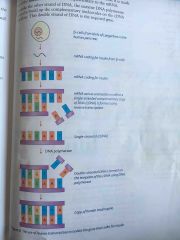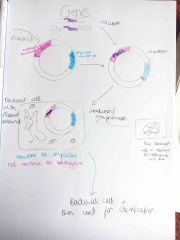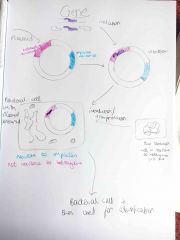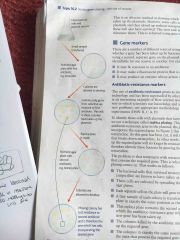![]()
![]()
![]()
Use LEFT and RIGHT arrow keys to navigate between flashcards;
Use UP and DOWN arrow keys to flip the card;
H to show hint;
A reads text to speech;
16 Cards in this Set
- Front
- Back
|
Stages of DNA technology |
1. Isolation 2. Insertion 3. Transformation 4. Identification 5. Growth |
|
|
Define transformation |
Transfer of DNA to host cell |
|
|
Reverse transcriptase method |

1. Cell with protein selected 2. Large quantities of relevant mRNA 3. Reverse transcriptase then makes DNA from RNA known as cDNA 4. DNA polymerase builds up the complementary nucleotides on the cDNA template 5. This DNA strand is now the required gene |
|
|
How Restriction Endonucleases create sticky enda |
1. Specific site called recognition sequence identified 2. Sticky ends are created when it's cut in a staggered fashion. 3. Palindrome sequence is typical for leaving sticky ends |
|
|
Why are sticky ends important |
2 sticky ends are completely complementary joint by DNA ligase They do not allow for contamination of the plasmid |
|
|
2. Insertion |
DNA needs to be joint to a vector commonly a plasmid The DNA fragment is inserted into the area where a gene for antibiotic-resistance used to sit REN cuts the plasmid open and the gene so they are sticky ends When incorporated DNA ligase joins the 2 together The plasmid is now recombinant |
|
|
3. Introduction/Transformation |
Plasmid and bacterial cells mixed into a medium with calcium ions along with temperature changes. This makes the bacteria permeable and the plasmid is easily taken up through the cell membrane |
|
|
3. I/T Why DNA frag is not taken up |
Only 1% of bacterial cells take up the plasmid Some plasmids close up again before taking the DNA |
|
|
Identification: 1 |

Add ampicillin to the growth and all those that survive have taken up the plasmid as without it they are resistant to nothing |
|
|
Identification: 1 |

Add ampicillin to the growth and all those that survive have taken up the plasmid as without it they are resistant to nothing |
|
|
Identification: Gene marker - antibiotic resistance markers |

Replica plating The new DNA has taken the place of one of the resistant genes so the bacterial cell is no longer resistant to tetracycline
By replica plating after stage 1, (adding the ampicillin which eliminates any bacteria without the plasmid) you can see which colonies are resistant to tetracycline and those that are do not have the required gene. Those that aren't resistant have the required gene and we can use the second plate to grow and colonise the bacteria. |
|
|
Identification: Gene marker - fluorescent markers |
Transfer of the jelly fish gene - green fluorescent protein The gene is inserted into the plasmid (so it no longer fluoresces) and then looking under the microscope to retain those that don't fluoresce |
|
|
Identification: Gene marker - fluorescent markers |
Transfer of the jelly fish gene - green fluorescent protein The gene is inserted into the plasmid (so it no longer fluoresces) and then looking under the microscope to retain those that don't fluoresce |
|
|
Identification: Gene marker - enzyme markers |
Lactase turns a colourless substrate blue Add the gene and it no longer turns it blue All those that do produce blue have no taken up the plasmid so we retain the ones that remained colourless |
|
|
In vitro cloning - polymerase chain reaction |
Requires: DNA fragment for copying DNA polymerase to join nucleotides (it's also thermostable so does not denature at high temps) Primers - sequence of bases complementary to the end of the DNA fragment to begin transcription Nucleotides Thermonuclear to vary temperature over time
Operation: 1. DNA strand is separated by being placed into a thermocycler at 95'C with primer and DNA polymerase 2. Primers anneal to the DNA fragment ends at 55'C providing the start sequence 3. DNA polymerase adds nucleotides to the DNA fragments at 72'C which is op temperature |
|
|
In vitro vs in Vivo |
In vitro: Rapid Does not require living cells
In Vivo: Useful for introducing a gene to a new animal by gene therapy No risk of contamination Accurate Specific genes cut out Produces transformed bacteria that can be used for products |

